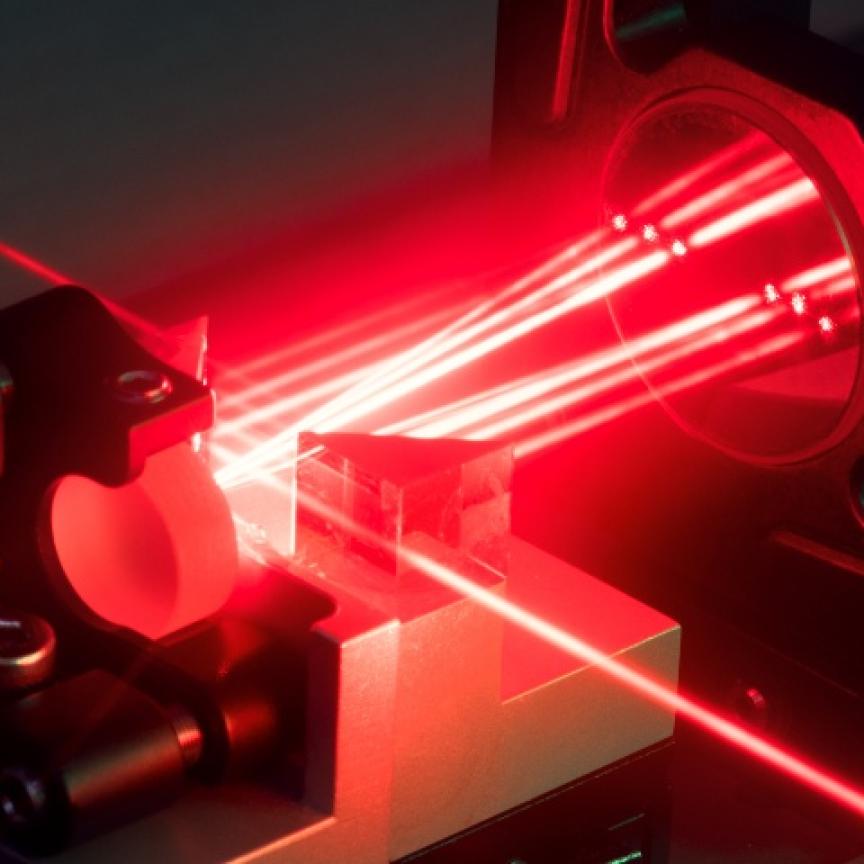As the last 20 years of ultrafast laser development has shown, increasingly powerful lasers create new markets and exciting new applications. As we are currently poised to start measuring the power of commercially available ultrafast lasers in kilowatts rather than watts, the range of applications looks set to explode.
Exciting new markets
From single-watt lasers used in lasik surgery, to 300-watt lasers cutting silicon, a range of applications have opened up with increasing wattage. Sometimes, however, the end use is not always obvious, as Vincent Rouffiange, VP of sales and marketing at Amplitude Laser, explained: ‘When we launched the first 20-watt lasers, lots of customers said, “nobody is going to use 20-watt lasers, [the power] is much too high”, and I got the same feedback for l00 watts. Nowadays we have 300-watt systems available commercially.
‘We are [now] developing a kilowatt system, and when we get a two kilowatt system I will find some customers who will benefit from it,’ he said. ‘Every time I get the same feedback from my customers. The existing customer is still going to use a 20-watt laser, but I’m going to open new markets that want [more powerful] lasers. We are opening new applications you cannot see and imagine today.’
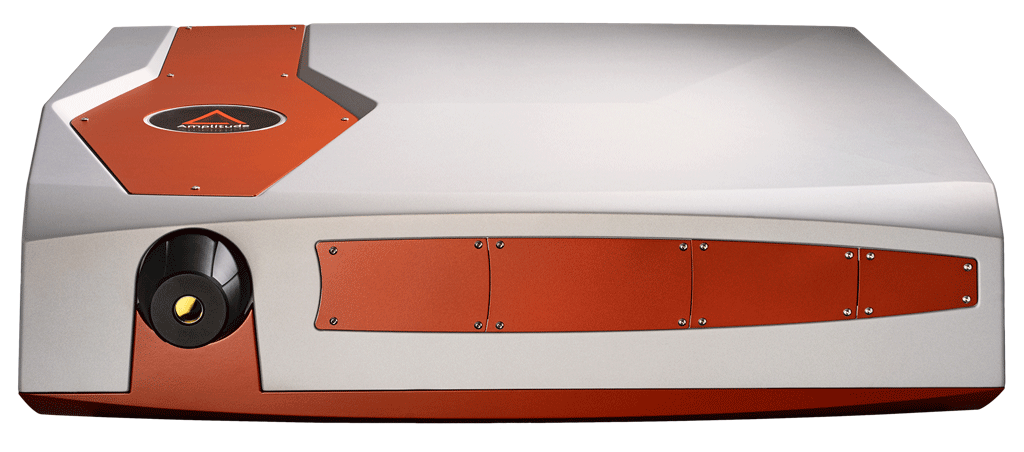
The Tangor 300 is Amplitude’s 300W commercial ultrafast laser. Credit: Amplitude
The increase in power typically provides the throughput that makes new applications commercially viable. Whereas texturing a car dashboard mould would take more than 70 days with a one-watt laser, with a kilowatt laser you can do this in two hours, which is an acceptable time length for mould texturing.
Now, as Rouffiange noted, at a time when people are increasingly concerned about the damage they are doing to the environment, ultrafast lasers are providing a more eco-friendly process. ‘The main difference in appetite from industry now is we are replacing some chemical processes. In the past, with a 10- or 20-watt laser what was replaced was either another laser or typically mechanical engraving. Now, from a green point of view, we don’t need to use these kinds of dangerous chemical processes.’
They are also enabling commercially viable products that couldn’t be manufactured to sufficient quality with other methods. One example that Hans-Dieter Hoffmann, head of Lasers and Laser Optics at the Fraunhofer ILT, gave was a new water filter: ‘We had an industrial customer who needed many tiny holes, billions of shaped holes in a metal sheet. They wanted to pump water through this metal sheet to remove all the micro and nano plastics in the water, so it could be used for drinking water, and it was important they could clean this filter regularly to make sure they always had the same pressure drop and same filtering efficiency.’
The billions of holes couldn’t be manufactured with chemical etching, explained Hoffman, because with this method it is not possible to get the required aspect ratio and hole shape. ‘In the beginning they took some 200-watt lasers, and with a 200-watt laser it took several days to do these billions of holes. Of course, that’s not commercially relevant, so we need this high average power, at least 10 times average power to come to reasonable throughput,’ Hoffman said.
The high quality of femtosecond lasers combined with the throughput possible with kilowatt powers offers a host of exciting innovations and improvements in quality.
French technology centre Alphanov is developing antibacterial surfaces with laser texturing for packaging and household appliances, while the EU-funded Multipoint project is developing a high-powered femtosecond laser for microdrilling the HLFC (hybrid laminar flow control) structures in aeronautics. In each case there is an increase in quality and efficiency and a reduction in cost and environmental impact of manufacture.
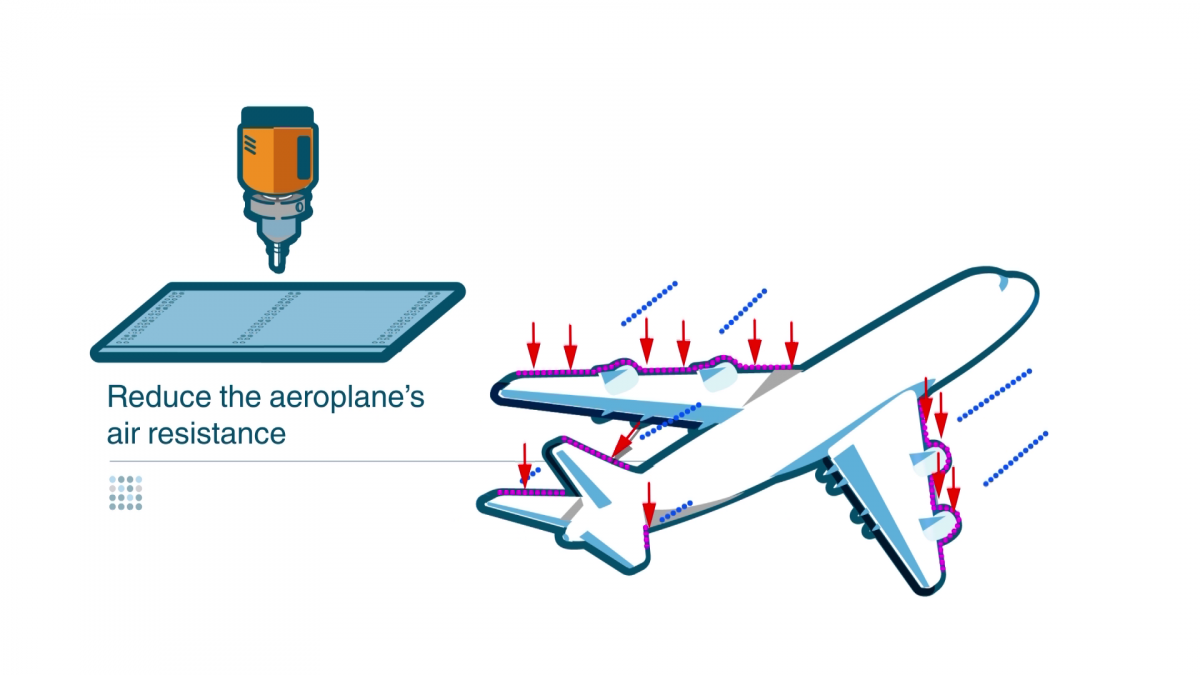
The EU-funded Multipoint project is developing a high-powered femtosecond laser for microdrilling the hybrid laminar flow control structures in aeronautics. Credit: Multipoint
Different approaches to multi-kW lasers
The department of lasers and laser optics at the Fraunhofer Institute for Laser Technology (Aachen, Germany), demonstrated in the lab around 10 years ago that femtosecond or sub-picosecond lasers could be scaled to one kilowatt. Led by Hans-Dieter Hoffmann, the research group is now taking the next step in power scaling, to generate average powers of up to five or even 10 kilowatts.
‘At the same time, we are trying to get high peak power and relevant part energy for specific applications, which means multi-ten microjoules up to multi-ten millijoules, with a pulse duration in the range of picosecond, even sub-picosecond down to around 30 femtoseconds,’ Hoffmann said.
Fraunhofer ILT is one of currently 13 institutes that form the Fraunhofer Cluster of Excellence Advanced Photon Sources (CAPS), with application labs in Aachen and Jena, where Fraunhofer experts can work with industrial partners. Hoffmann explained the different approaches taken by the two labs:
‘Our colleagues at the Fraunhofer IOF in Jena are using an approach of coherent combining of many individual fibres,’ he continued. ‘They have combined up to 12 fibres coherently to get one monomode output beam, and they could demonstrate average powers up to 10 kilowatts of average power. At Aachen we are looking at a single beam amplifier approach, so we have larger cross sections of our Innoslab lasers, our thin disc lasers, and we can generate up to 10 millijoules and multi-kilowatt output directly in a single beam.’
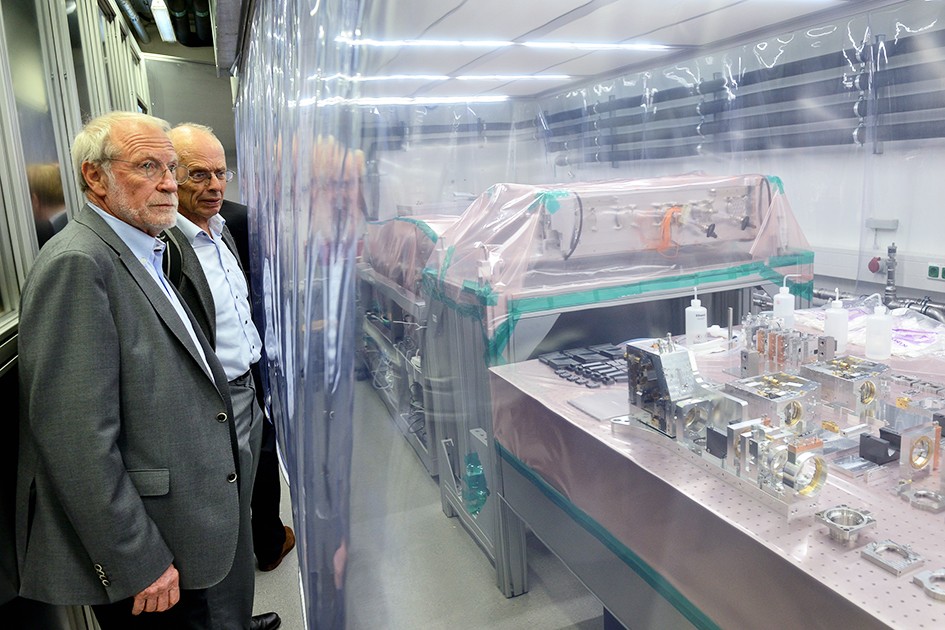
One of the application laboratories in Aachen, part of the Fraunhofer Cluster of Excellence Advanced Photon Sources (CAPS)
Both options have been shown to be viable, which should increase the range of applications where the lasers can be used.
Challenges to overcome
While the development of multi-kilowatt femtosecond lasers have significant potential in terms of quality and throughput, there can be significant challenges in the application of these powerful lasers.
Users want a non-thermal ablation, high quality processing of the material without damaging the material, but at the most basic level, if you put a kilowatt femtosecond laser on one position, it damages the material. As Hoffmann explained, however, there are different approaches that can be taken to help overcome this: ‘One option is to have a very, very high scan speed, this can be done by some polygon scanners, where you can have speeds up to many, many hundreds of metres per second. Another option is to use some parallelization, so we can drill hundreds or thousands of shaped holes simultaneously, and that’s done by some optical system, including some diffractive optical elements, and some imaging system.’
Amplitude and Fraunhofer ILT are part of the Multiflex project consortium, where they are splitting the beam of a kilowatt laser into multiple beams. They are able to control each of these beams independently to make texturing at high speed, which can be used in aeronautics or the antifouling structures for ship hulls.
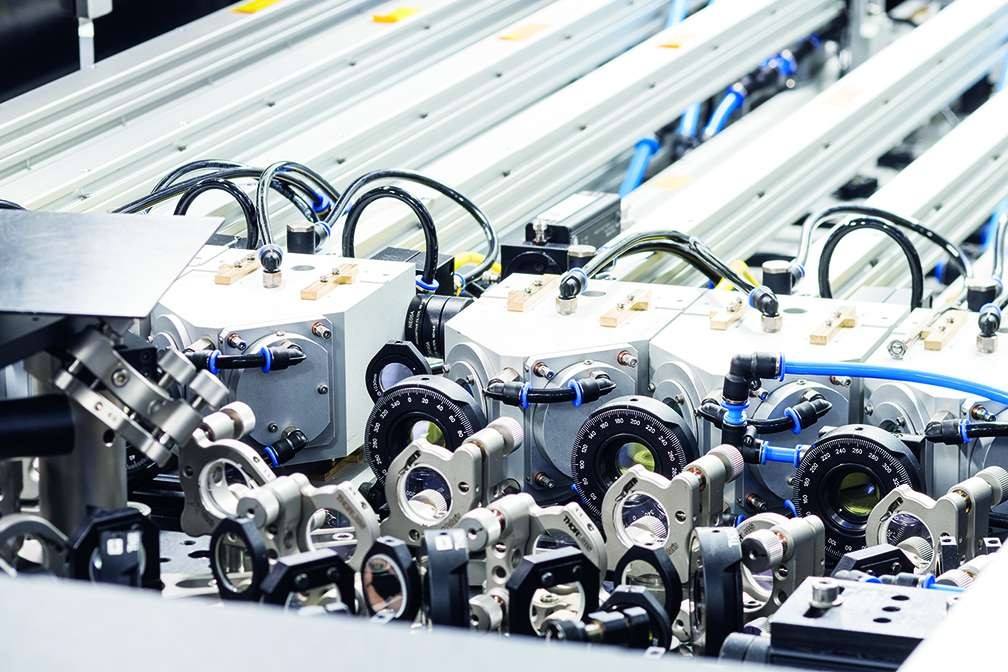
The scaling of the multi-kW ultrafast fibre laser at Fraunhofer IOF is based on the coherent combination of several individual beams
There are often compromises that need to be made, such as in the development of the laser at Aachen, Hoffmann noted: ‘There are many individual bottlenecks. We have to manage the average power, we have to manage some thermal effects in the laser medium, but also in the pump optics. You have to imagine that such a laser has typical optical efficiency of 50 per cent, so this means only 50 per cent of the total power is converted to femtoseconds – but we have to manage this comparatively high output power.
‘To have 2.5-kilowatt average output power, you need something like five kilowatts of pump power, and you have to manage this amount of power in your optical system – it should be as compact as possible, you have small beam cross sections, and you have to manage this comparatively high thermal load on all the coatings and optics,’ Hoffman explained.
Femtosecond lasers not only have a significant impact on the coatings and optics, but as Sara Castillo, laser optics sales specialist at Edmund Optics, explained, different pulse lengths raise different challenges and require compromises: ‘With really short pulses – those in the order of a couple of 10s of femtoseconds, or even below 10 femtoseconds – it’s a completely different story than with pulses of several hundreds of femtoseconds. The challenge here is due to the inverse relationship between pulse duration and wavelength bandwidth: the shorter the pulses get, the broader the wavelength range your optical coating must cover.’
To manufacture such a coating, Castillo added, you need different materials for the various layers in the thin film stack that are able to be both highly transmissive and provide a large refractive index contrast at each wavelength in the bandwidth. ‘The broader the wavelength range, the more difficult it is to find materials that satisfy those requirements. For example, you would typically use niobium or titanium oxide in the stack as high index material if you want to make a broadband mirror coating, but then that material is not very resistant to high laser powers,’ she said. ‘Ultimately, it’s a compromise: if you want to have higher laser power resistance, you would probably then use hafnium or zirconium oxide, but then you need more layers and precision to cover a broad wavelength range, due to the reduced refractive index contrast.’
With pulse durations of a few femtoseconds, the group delay dispersion (GDD) becomes the major issue, since each wavelength will travel at a different phase velocity. When working with nanosecond pulses, this phenomenon is not really important, Castillo said, but when working with femtosecond pulses, every transition through a lens or a window will create dispersion and lengthen the pulse duration. ‘Though it is possible to create GTI- [Gires-Tournois-Interferometer] chirped-mirrors, or even pairs of chirped-mirrors to compensate for this dispersion, the biggest challenge comes when making mirror pairs, since they require not one, but two complex coatings with oscillations of the GDD that compensate each other,’ said Castillo.
As the market continues towards increasingly higher laser powers, Edmund Optics expects the intrinsic laser damage threshold of the coating materials, or the electric field distribution within the layer stack, to cause problems for higher power femtosecond laser optics in the future. ‘For example, at higher laser powers you would maybe want to use a mixture of materials capable of withstanding such power. However, this approach usually reduces the refractive index, so you would need to make the layer thicker, but then the thicker the stack, the more material required, and the more it costs to manufacture,’ Castillo explained. ‘Alternatively, you could adopt the strategy of making the beam larger. On a larger beam you are not concentrating all the power on a tiny area, and are instead distributing that power on a larger surface area, making it easier for the coating to withstand the full laser power. However, the larger the beam, the larger the optics required, and the more difficult it is to keep tight specifications of surface quality and GDD across the whole optic surface.’
The challenges involved in developing multi-kilowatt ultrafast lasers are substantial, but so are the rewards, and as the research labs have shown, the challenges can be overcome.
New ultrafast lasers promise a host of higher quality and more efficient products at a reduced cost and with less environmental impact in many new markets. The work has already begun in some of the areas where they will be applied, but there are many other applications that have not even been dreamt of yet.
Ultrafast lasers for quantum dot control
Quantum dots (QD) are appealing for a variety of applications and new technologies due to their unique size and composition. Depending on the elemental composition, QDs are suited to bioimaging, diagnostics and biosensing applications in biomedical and environmental sciences.
One application for research is to label living biological material in vitro and in vivo in animals – they can be injected into cells or attached to proteins to track, label, or identify specific biomolecules. In the future, quantum dots may be used to treat and monitor diseases such as cancer in humans.
The realisation of a QD single-photon source, or the creation of entangled photons, is often based on three key elements: a QD emitter, appropriate control of the emission process, and non-linear optical processes.
Controlled single-photon generation ‘on demand’ can be achieved by pulsed excitation of the single photon emitter. Compared to femtosecond sources, picosecond lasers are particularly narrow-band, and therefore enable resonant excitation of the QD emitter efficiently and without disturbing background emissions.
To achieve an optimal resonant excitation condition, the spectral bandwidth of the excitation light source has to match the absorption bandwidth of the desired transition process. Since the optimal spectral bandwidth depends on the properties of the individual QD emitter system, a pulsed excitation source with adjustable spectral bandwidth and the capacity to fine-tune the centre wavelength may be considered advantageous.
APE in Berlin, exclusively represented by Photonic Solutions across the UK and Ireland, already offers the perfect solution for the field of quantum research, quantum-microscopy, or ghost imaging. The combination of the picoEmerald tunable picosecond NIR source and pulseSlicer spectrum slicer offers ultimate control of the emissions process of QDs.
Key features include:
•Narrow bandwidths for high selectivity (resonances in the sample are close together)
•Automated wavelength tunability of the picosecond laser to address different resonances
•Automated adjustable bandwidths to optimally address resonances of different widths (pulseSlicer)
•High repetition rate for small time constants, since the relatively weak single-photon signals have to be accumulated over a large number of measurements
•High spectral power density (narrow bandwidth) given by picosecond laser excitation
•Two colour experiments with independently adjustable wavelengths possible.
Compared to Ti:Sapphire, the picoEmerald offers a wider tuning range (from 700nm to ~ 2µm), and covers the telecom wavelength range. However, standard Ti:Sapphire systems with ~100fs can also be adapted to meet the QD requirements with the use of the pulseSlicer. At ~950nm, an output spectral bandwidth of 0.02nm (that is, >60ps pulse duration) has already been demonstrated.
Since the transmission efficiency of the pulseSlicer is determined by the ratio of the spectral input and desired output bandwidth, the average output powers are rather low when femtosecond sources are used. However, this is not a disadvantage. The requirement for average power is in the sub-mW or even µW range. This opens up the possibility that existing femtosecond and picosecond Ti:Sapphire lasers can be extended accordingly.
In addition, APE’s tunable optical parametric oscillator (OPO) can be used to extend the wavelength range of these lasers. Wavelengths in the following ranges are available in different versions: IR (1,000 to 1,600nm), VIS (505 to 740nm), and extended IR (1,750 to 4,000nm).
The standard pulseSlicers offered by APE are for the NIR (650 to1,080nm) or the IR range, which covers the Telecom wavelength of 1,550nm. At this wavelength a spectral bandwidth of 0.04nm can be achieved. Furthermore, the manufacturer from Berlin, Germany, is always open for requests outside the standard range. Handling is completely software controlled after the initial installation and thanks to the motorised components. Finally, the device allows a fine tuning of the output wavelength in the range of the applied input wavelength.
These solutions are already finding success in a variety of application areas. Hopfmann et al at the Institute for Integrative Nanosciences in Dresden carried out, with a Levante Emerald long-pulse version, the first comprehensive study on deterministic spin preparation employing excited state resonances of droplet etched GaAs quantum dots1.
Zeuner et al used a picoEmerald, together with a pair of PulseSlicers (one each for the NIR and IR outputs), for ‘on-demand generation of background-free single photons’ at 1,548nm2, as well as ‘on-demand generation of entangled photon pairs’ at 794nm3.
Brian Gerardot et al utilised an APE PulseSlicer for a number of purposes4,5,6, including to ‘probe the role of coherence in cooperative emission arising from two distant but indistinguishable solid-state emitters’4.
Contact: sales@photonicsolutions.co.uk
References
1. “Deterministic preparation of spin qubits in droplet etched GaAs quantum dots using quasi-resonant excitation” Hopfmann et al. (Institute for Integrative Nanosciences, Dresden)
2. “On-demand generation of background-free single photons from a solid-state source” Schweickert et al. (Royal Institute of Technology, Stockholm)
3. “On-Demand Generation of Entangled Photon Pairs in the Telecom C‑Band with InAs Quantum Dots” Zeuner et al. (Royal Institute of Technology, Stockholm)
4. “Coherence in cooperative photon emission from indistinguishable quantum emitters” Gerardot et al. (Heriot-Watt University, Edinburgh)
5. “Coherent Dynamics in Quantum Emitters under Dichromatic Excitation” Gerardot et al. (Heriot-Watt University, Edinburgh)
6. “A bright source of telecom single photons based on quantum frequency conversion” Gerardot et al. (Heriot-Watt University, Edinburgh)


